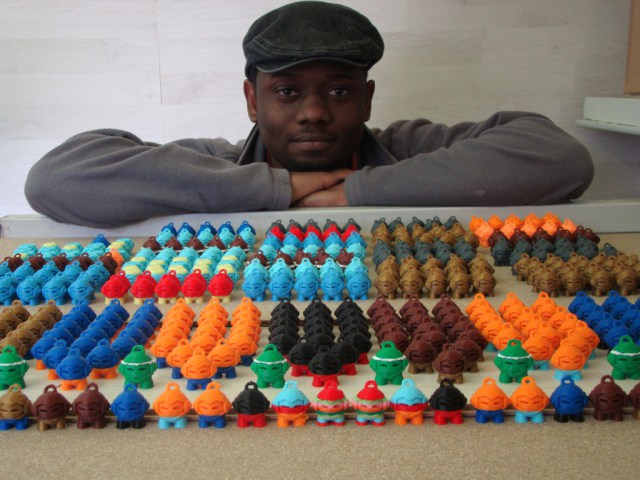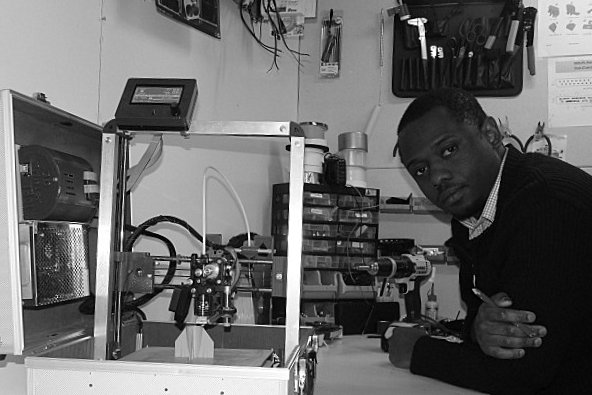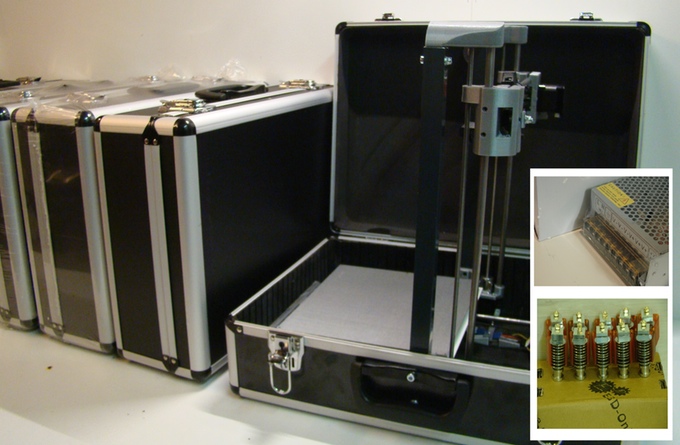Three days after the campaign went live on Kickstarter, Emmanuel’s mobile/suitcase 3D printer, TeeBot had hit its funding goal with funds still pouring in.
After that story, TechCabal caught up with Emmanuel Adetutu to talk about TeeBox, where it came from, the man behind it and where all these lead to.
Emmanuel is based in the Netherlands, but he is one of the homegrown geniuses, in fact, the whole idea of a foldable mobile 3D printer was inspired by Nigeria, he tells us.
***
TechCabal: Congratulations on crushing your Kickstarter funding goal. You’ve more than tripled your funding goal; raising EUR 17,000 from a EUR 5, 000 funding goal, with 6 days to go, no less. Did you expect this level of engagement and support?
Emmanuel Adetutu: Thank you, No I never expected this level of reaction. I was surprised and have had amazing support and comments from the Kick-starter campaigners.
How do think you were able to rack up this level of support?
TeeBot suitcase is a simple desktop 3D printer. I think people love the fact that it can be folded and moved around easily.
What is TeeBot/TeeBotMax (whats the difference between those two?) and where did the idea for a foldable, mobile 3D printer, come from?
TeeBot/TeeBotMax are both desktop 3D printers which I designed and developed and the difference is in the maximum printable object which each printer can achieve. TeeBot has a print volume of 16cm x 20cm x 18cm, while TeeBot Max is 20cm x 20cm x 20cm on all 3 sides.
The idea came a few years ago when I bought and assembled a DIY 3D printer. I loved it and used it every single day to print stuff around the house and parts for other hobby projects. I wanted to travel down to Africa (Nigeria) with the printer to show my friends what can be built with a 3D printer, but it was too large and bulky. Then I set about modelling and building my own 3D printer as a hobby project. I had the first prototype working and everywhere I went, everyone liked it and I never stopped improving on it at my spare time.
How long have you worked on this and what’s your big dream for this project? What are the immediate plans for the fund from Kickstarter?
Roughly 3 years working on the design and development at my spare time.The big dream here is that every creative person, mostly youths can have easy access to a 3D printer or own one. I hope to help achieve this by sharing my knowledge of 3D printing and also designing and creating an affordable high quality 3D printer.
Majority of the funds will be used to create the 3D printer and reward backers with a TeeBot 3D printer..
I have 3D printed 500 “Marvins Key holder/ Key-rings” to freely distribute to those we believe have never seen a 3D printed object and also to test the 3D printer. The fund will also be used in distributing these 500 Marvins.

Profits made will also be used to acquire new tools and equipment to help in research and development of the 3Dprinter and also sponsor youth development initiatives which I support by donating 3D printers and related materials. Until now, a total of four 3D printers has been donated to such programs in Africa.
Are you making money off this, do you even plan to?
Yes, when I can, I offer 3D print services to help customer’s 3D print their 3D models/object via the 3Dhubs platform which connect 3D printer owners to individuals who like to 3D print locally at a fee. Also via 3DstuffsNL to help in the supply and assembling of 3D printers and related services.
3D printing is not exactly a pressing topic in the African technology ecosystem right now. Why do you think this is so?
There is little or no awareness on the technology in Africa. You must realize that the technology itself is new and developing, but I believe with proper awareness and programs including training and workshops Africa will be one of those to immensely benefit from the technology.
Are discussions on 3D printing relevant in Africa right now? To what problems can open-source 3D printing apply in Africa?
Yes, the 3D printer is a tool which properly put into use can create solutions and products.
A few examples;
- Students and professionals can create prototypes of bigger projects easily example here
- Building models example here
- Prosthetic’s example here
- Everyday object can be printed on your desktop example here
Share your background with us. Did you grow up in Nigeria? How does the creative hardware industry in Nigeria compare to that of the Netherlands?
I grew up in Kaduna, Nigeria and attended LAUTECH in Ogbomosho for my university degree in Computer Science, before pursuing a postgraduate course in Geographic Information Systems (GIS) at Ile-Ife and then a masters degree in GIS in the Netherlands.
Growing up, I was surrounded at home in Nigeria with power tools and machines where I learnt to build stuffs at an early age.
The Netherlands is a very innovative country with respect to technology. The country boasts of one of the most inventive cities in the world and also the origin of Philips. Nigeria will benefit more by tapping into the creativity of its resources and creating an enabling environment for accelerating local hardware industries and also investing in the training of its skilled and creative youths. That change is already happening in the software sector with rise in incubation and acceleration programs in programming and IT related developments. Similar incubation and acceleration programs adopted for hardware industries will help technology hardware developers to develop, create and deploy their initiative to where it is needed.
You work as a Data Analyst at Nokia HERE in Netherlands. I imagine that’s an engaging work on its own. How are you able to combine that with open-source 3D printing? And also being the CEO of 3DstuffsNL?
Both are engaging and exciting!! I work with HERE a NOKIA company as a Data Analyst with specialization in geographic information system (GIS) where I design, create and implement test processes and tools around large spatial database used mostly in the navigation systems and platform.
3D printing started as a hobby, having built a few machines in the past including CNC machines for hobby related projects. 3DStuffNL was founded due to demands to help source related materials and supply TeeBotMax and TeeBot 3D printers.
You are working on TeeBot with Paul Lammerts. What are your individual roles in developing the printer?
I designed and developed the 3Dprinters. However after a successful Kick-starter campaign a handful of TeeBot 3D printers will need to be built and assembled. The pre-assembling will be done by an organization called Lijn64 where Paul works. His role is to coordinate the assembling of the TeeBot 3D printers for the Kick-starter project.
What are your thoughts on hardware technology manufacturing in Africa?
Africa is a continent with most of all the raw materials used in the manufacturing industries. Africa is also a major export of technical skills required in these industries. What I find missing is the enabling environment and conditions required for manufacturing to take place at a large global scale. However I believe Africa is the Next “China” with the vast amount of undeveloped areas and large human resources, Africa to me is where the next technological developments will emerge from.
Editor’s note: The campaign is still live on Kick-starter and you can still back the project. Check it out.
Discuss this post on Radar.














